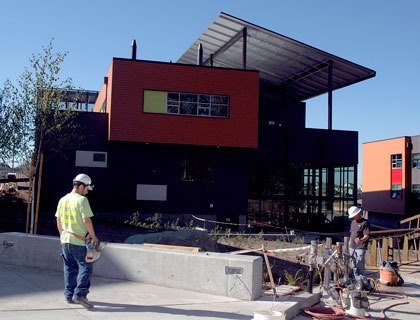MARYSVILLE — As students arrived for orientation Aug. 24, construction crews continued to prepare Marysville Getchell High School for its first day of school Sept. 7.
According to Marysville School District Capital Facilities Director John Bingham, the vast majority of the work is already done, and the biggest task left is simply relocation.
“The house is built and now we’re moving in,” Bingham said. “By the first day, there will still need to be some landscaping done on the front entry and the upper ball field will be seeded but not yet germinated. We’ll have a punch list of to-do items, like dings in the paint and maybe some light switches on the wrong side. Our maintenance staff also needs to complete their training for these buildings. It’s principally just tweaks, though.”
A larger item that will not be complete in time for the first day of school is Ingraham Boulevard, the arterial that will connect 88th Street NE to Highway 9 and provide a less steep road to Marysville Getchell than its current access road of 84th Street NE.
City of Marysville Public Works Director Kevin Nielsen explained that the delay in Ingraham Boulevard’s expected completion, until the latter half of October, is partly the result the number of state and federal permits that the city was required to obtain to place a culvert in the Grace Creek basin as part of construction. Nielsen noted that these permits and the seasonal weather set certain limits on when construction could take place, especially with Marysville Getchell opening a year ahead of the original schedule.
Bingham expressed confidence that traffic at Marysville Getchell would adjust, just he believes it did at Grove Elementary, which opened with road construction still underway in 2008.
In the meantime, Bingham was happy to show off some sights that aren’t open to the public yet, including the recently completed gymnasium, with bleacher seating for 900, and the synthetic turf of the campus’ backup football field, whose bleacher seating for 200 isn’t installed yet. The field will not host varsity football games, but it will host track-and-field events.
“We used the savings from the school construction to upgrade from the original natural turf,” said Bingham, who added that much of the preexisting forestry had been kept to serve as study areas and act as a natural sound barrier between the campus and the surrounding residential neighborhoods.
Bingham touted a number of details meant to be transparently effective, such as handrails for stairs and walkways that include under-lights and built-in heaters for cold and dark days. The central library spaces in the middle of each of the three floors of the four Small Learning Community buildings on campus mount their shelves on wheels to make those spaces more multi-use accessible.
“There are really good library resources everywhere, but that’s also a challenge, since we have to keep track of 12 different library spaces,” said Susan Gregorson, a librarian at the International School of Communications. “The process of moving 10,000 new books and 5,000 existing books without elevators has been painful, but everyone has pitched in. I love how beautifully open these high-tech buildings are.”
Vince Cotroneo, a counselor at ISC, seconded Gregorson’s compliments of the buildings’ designs.
“Kids will be lingering around out here,” Controneo said, indicating the auditorium seating outside of his glass-walled office on the front entry second floor of the SLC. “When they hang around long enough, that’s when they start talking.”
Eric Lefstad, a science teacher at Marysville-Pilchuck High School for more than a dozen years, sees the challenge of acclimating to a new campus as another learning opportunity for his students.
“It fits in with my philosophy,” Lefstad said. “The students can approach problem-solving by seeing how adults handle new systems. If you can’t adapt, you’re in trouble. They have to be willing to try something new without worrying whether they’re going to fail. I love this learning space.”
The average number of construction workers on site has dropped from 100 at the height of construction to 60 currently. As students posed for photos and filled out forms as part of their orientation, administrators like School for the Entrepreneur Principal Dave Rose praised the layout of the campus, even as they acknowledged the difficulty of dealing with ongoing construction.
“The construction workers tell you when you can move, and you get to hear the noise when they regrind the floor,” Rose said. “But we’re blessed with so many beautiful views and everything is so accessible. Each building is so self-contained, but it doesn’t isolate the students from one another at all. Our school store serves the whole campus and can be accessed from anywhere. Students can take pride in their own schools and we can all build our own culture here, starting fresh with a new atmosphere.”



